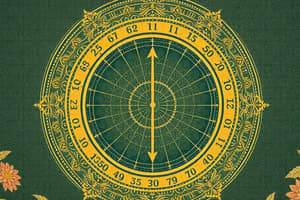Podcast
Questions and Answers
What is a measurement?
What is a measurement?
- A tool used to make measurements
- A specific value that describes a physical quantity (correct)
- A device used to convert units
- A standard unit of measure
Why are unit conversions important in measurements?
Why are unit conversions important in measurements?
- To compare measurements made in different units (correct)
- To increase the accuracy of measurements
- To complicate the process of measuring
- To standardize all measurements
What is the SI system mainly used for?
What is the SI system mainly used for?
- Measuring volumes
- Standardizing units of measurement (correct)
- Converting units
- Comparing significant figures
Which of the following is NOT a commonly used conversion factor?
Which of the following is NOT a commonly used conversion factor?
Why do significant figures matter in measurements?
Why do significant figures matter in measurements?
What does scientific notation help with in measurements?
What does scientific notation help with in measurements?
Which of the following is NOT one of the base units of the SI system?
Which of the following is NOT one of the base units of the SI system?
If a ruler measures an object's length as 7.35 cm, how many significant figures does this measurement have?
If a ruler measures an object's length as 7.35 cm, how many significant figures does this measurement have?
What is the scientific notation for 0.000089?
What is the scientific notation for 0.000089?
How many significant figures are in the measurement 4500.0 grams?
How many significant figures are in the measurement 4500.0 grams?
What does 'kg' represent in the SI system?
What does 'kg' represent in the SI system?
Which unit is used for measuring luminous intensity in the SI system?
Which unit is used for measuring luminous intensity in the SI system?
Flashcards are hidden until you start studying
Study Notes
Measurements and Units
Measuring the world around us is a fundamental part of human existence, and understanding measurements and the units used to represent them is essential. This article will delve into the intricacies of measurement, unit conversions, the standardized SI units, and significant figures, providing you with a solid foundation in this crucial field.
Measurements
A measurement is a specific value that describes a physical quantity, such as length, mass, or time. Measurements are made using physical instruments called measuring devices. For instance, you might measure the length of a book with a ruler or the time it takes to cook a meal with a kitchen timer.
Unit Conversions
Units are standards of measure that quantify physical quantities. They are essential for comparing measurements made in different units. For example, you might measure the length of a book in centimeters (cm) but be interested in knowing its length in inches (in). To do this, you would convert the measurement from centimeters to inches using a conversion factor, such as 1 cm = 0.3937 inches.
Unit conversions are a critical component of measurements. They allow us to compare measurements made using different units and work with measurements from various sources. Commonly used conversion factors include those for length, mass, and temperature.
SI Units
The SI (Systeme International d'Unites) is the international standard system of units for measurement. Adopted in 1960, the SI system is widely used for scientific, technological, industrial, and commercial purposes.
The SI system has seven base units that represent fundamental measurements: meter (length), kilogram (mass), second (time), ampere (electric current), kelvin (temperature), mole (amount of substance), and candela (luminous intensity). Each base unit has a unique symbol and name. For example, meter is represented as m, and kilogram as kg.
Significant Figures
Significant figures are the digits in a measurement that have a known precision. For example, if you measure the length of an object as 3.5 cm, the significant figures are 3 and 5. The zeros in between are not significant.
The number of significant figures in a measurement depends on the precision of the measuring instrument used and the method of measurement. For instance, if you measure the length of an object with a ruler that has a precision of 0.1 cm, the measurement will have two significant figures: 2.8 cm.
Rounding measurements to the correct number of significant figures is essential for accurate communication and analysis of data.
Scientific Notation
Scientific notation is a way of representing very small or very large numbers using an exponent to indicate the position of the decimal point. For example, the number 0.0000001 could be written in scientific notation as 1 x 10^-7, and 1,000,000 could be written as 1 x 10^6.
Scientific notation is particularly useful for working with very large or very small numbers, as it simplifies calculations and makes them easier to perform. It is also used in the SI system for expressing small and large units, such as picometers (pm, 10^-12 meters) and exoplanets (10^21 kilometers).
Conclusion
Understanding measurements, unit conversions, SI units, significant figures, and scientific notation is essential for working with data and interpreting information. These fundamental concepts are used in a wide range of fields, from everyday life to scientific discovery. By mastering these ideas, you will be well-equipped to navigate the world around you and make informed decisions based on accurate and reliable measurements.
Studying That Suits You
Use AI to generate personalized quizzes and flashcards to suit your learning preferences.




